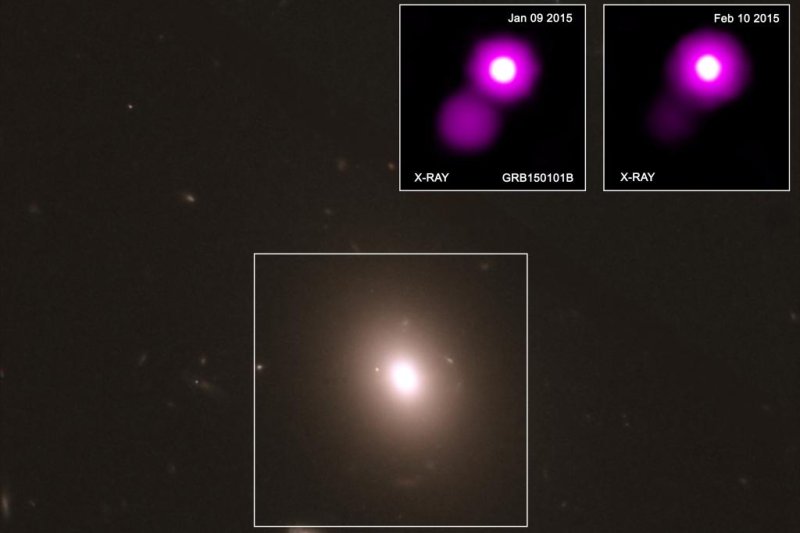Observations by the Chandra X-ray Observatory, the Hubble Space Telescope and the Discovery Channel Telescope provided astronomers multiple perspectives of the gamma ray burst. Photo by NASA/CXC
Oct. 17 (UPI) -- Scientists have discovered a cousin of the cosmic collision that produced the first gravity and light waves to be traced to a common source.
Last year, astronomers triangulated incoming gravity waves to a common source, the merger of two neutron stars. Now, scientists have discovered a direct relative of the gravitational wave event.
The new object, GRB150101B, is a gamma ray burst. Though originally detected by NASA's Neil Gehrels Swift Observatory, astronomers have used Chandra X-ray Observatory, the Hubble Space Telescope and the Discovery Channel Telescope to analyze the object's spectral patterns.
The analysis revealed strong similarities between the spectral signatures of the gamma ray burst and the gravitational wave event.
Astronomers detailed their comparison of the two events in a new paper published this week in the journal Nature Communications.
The data suggests both events were produced by the same kind of cosmic collision, the merger of two neutron stars.
As Chandra, Hubble and the the Discovery Channel Telescope revealed, both events produced a gamma ray burst, as well as bright, blue optical light and X-ray emissions. The events were also both traced to similar galaxies of the same age -- bright elliptical galaxies, both several billion years old.
"We have a case of cosmic look-alikes," Geoffrey Ryan, a postdoctoral researcher at the University of Maryland and a fellow at the Joint Space-Science Institute, said in a news release. "They look the same, act the same and come from similar neighborhoods, so the simplest explanation is that they are from the same family of objects."
Both events were off-axis, which means the gamma ray bursts' jets weren't pointing directly at Earth. And each collision produced a kilanova, a bright flash of radioactive light. Kilanovae are one of the cosmos' main source of heavy metals; their intense radiation forge silver, gold, platinum and uranium.
The two objects aren't twins. While the gravitation wave event, GW170817, occurred just 130 million light-years from Earth, GRB150101B was traced to a galaxy 1.7 billion light-years away. Additionally, GRB150101B failed to produce a detectable gravitational wave.
As astronomers become more adept at tracking cosmic events using multiple telescopes and observatories, they hope to uncover new details about the relationships between different types of collisions and mergers.
"Surely it's only a matter of time before another event like GW170817 will provide both gravitational wave data and electromagnetic imagery. If the next such observation reveals a merger between a neutron star and a black hole, that would be truly groundbreaking," said Alexander Kutyrev, an associate research scientist at Maryland and NASA's Goddard Space Flight Center. "Our latest observations give us renewed hope that we'll see such an event before too long."















